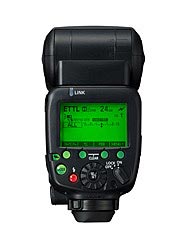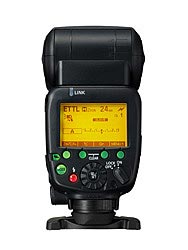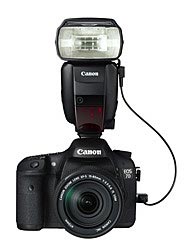Speedlite 600EX-RT is the new Canon's flagship flash unit. It features the revolutionary built-in radio triggering technology and a significant number of other improvements over 580EX II model. (For in-depth comparison, please refer to Canon Speedlite 600EX vs. 580EX II review.) In some countries, Speedlite 600EX (which is identical to 600EX-RT except for the radio triggering) is also available to photographers. Radio-based triggering gives you flexibility because the range is longer compared to the optical triggering, and you are not limited by the line-of-sight. Canon Speedlite 600EX-RT, however, takes it even further by offering a number of unique features and improvements based on the radio technology.
Please note that you cannot use optical and radio-based wireless triggering at the same time. You have to set all your flashes to either optical or radio mode, which means that if you use flashes other than Speedlite 600EX-RT (including all third-party flash units), optical triggering is your only option.
 |
 |
First things first. In radio mode, you can trigger your flashes from almost 100 feet (30 m) away. If you compare it to optical triggering, it gives you 2-2.5 times longer range indoors. The improvement is even greater outdoors, where with optical technology, you only get 26-32 feet (8-10 m). So, the radio range is 3-4 times longer in this case.
When in radio mode, you can place your flashes virtually anywhere without worrying about the line-of-sight. Flashes do not have to "see" the master unit. You can hide them behind obstacles, place behind the master, etc.
Instead of the usual 4 channels, which can be limiting in a room with many photographers shooting wirelessly, Canon Speedlite 600EX-RT offers 15 radio channels. Depending on where you shoot, however, some of the channels may not be usable because of interference from household devices, for example. The best channel is selected for you automatically, but you can always scan all channels available and choose the one you want.
The "unlimited" part comes with the Radio ID feature. Regardless of the channel you select, you can assign a 4-digit ID to your flashes. There are 10,000 ID's available (from 0000 to 9999). So, even when several photographers are using the same channel, they are not going to trigger each other flashes if everyone is using a unique Radio ID. The number of channels and ID's should be quite sufficient for any situation unless there is more than 150,000 Canon photographers shooting within a 100 feet from you :).
One of the groundbreaking features introduced with 600EX-RT is the two-way communication between the flashes. The slave units send a signal back to the master unit when they are re-charged. On the master unit, you can see when each wireless group is ready for the next shot. (A group of flashes is considered to be ready when every unit in the group is ready.)
Radio mode adds two more wireless groups. In addition to A, B, and C, you also have D and E groups. (A total of 15 flashes can be triggered.) Each of five groups can be controlled absolutely independently: flash mode, exposure compensation, etc. Unfortunately, as of now, this is only possible with the latest camera bodies, like EOS 5D Mark III or EOS-1D X.
If you ever had fun using stroboscopic mode of your flash, you might appreciate being able to more than double the frequency of the light pulse. Speedlite 600EX-RT can go as high as 500Hz in stroboscopic mode, while the optical one is limited to 199Hz. This, again, is not a feature for everyone to use, but it can be critical in some high-speed applications.
With two 600EX-RT flashes you can trigger your camera remotely. Put one flash in the camera's hot shoe and place another one anywhere within about 100 feet (30 meters). With a push of a button on the second unit, you can release the shutter of your camera. Please note that the flash on the camera does not have to fire, but it can if you want it to. With the newer cameras like Canon 5D Mark III, for example, the remote triggering works via the hot shoe. For older camera models, you will need Canon SR-N3 cord (make sure your camera has a N3-style socket).
 |
In a way, similar to the remote triggering described above, Linked Shooting allows to take images with multiple cameras at the same time. If you have multiple cameras set up from different angles, you can trigger all of them at once if each camera has a 600EX-RT unit in its hot shoe. Again, it is a rather advanced feature, but sport photographers, for example, might really appreciate it.
As we already mentioned, some of the new cool features are only possible with the very latest cameras. Also, according to Canon, the maximum sync speed is 2 times slower for all older bodies, which means you can only sync at 1/100th of a second with Canon 5D Mark II, or 1/125th of a second with Canon 60D.
Radio E-TTL mode is not possible with EOS-1D (Mark I), EOS-1Ds (Mark I), EOS-1v, EOS-3, EOS Elan IIE (EOS 50E), and 35mm film-based EOS Rebel models. The radio-based triggering is not recommended to be used with PowerShot cameras.
Canon Speedlite 600EX-RT introduces an amazing new technology. Radio-based wireless triggering offers 2-4 times longer range, feedback from slave units, 5 independently controlled groups, thousands of channel/ID combinations, and more. With many other advantages over the previous models, it is arguably the best flashgun on the market today.